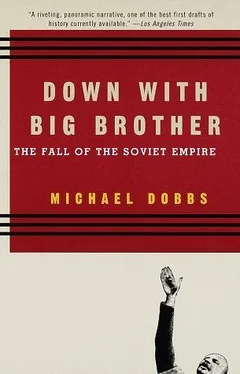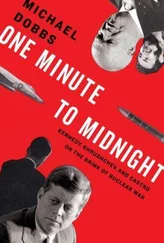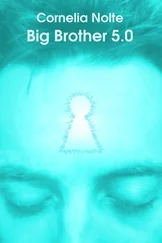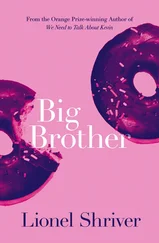The extensive economic model was retained by Stalin’s successors, with only slight modifications. Both Khrushchev and Brezhnev had a weakness for huge projects that would exploit the country’s untapped resources. Khrushchev developed the virgin lands of northern Kazakhstan in a vain attempt to solve the food crisis. Brezhnev ordered a railway line to be built across the frozen tundra of northern Siberia to reach the copper reserves of Udokan and the gold mines of Yakutia. By the early eighties the Soviet Union led the world in such basic economic indices as the production of iron, coal, timber, and cement. It boasted the world’s biggest hydroelectric dam, largest steel factory, heaviest tractors, most powerful rockets. At the same time, industry was unable to produce a decent razor blade or meet the demand for toilet paper.
What the Novosibirsk reformers proposed was a switch from extensive to intensive growth. Quality, not quantity, would become the new buzzword. Western studies had shown that a Soviet factory consumed two to three times as much energy as a Western plant to produce an inferior product. The technological gap between the Soviet Union and the West was growing all the time. By 1982, the year of Brezhnev’s death, the Soviet Union trailed the United States in the number of computers per head by a factor of 1:400 and in the number of industrial robots by 1:15 180
Compared with later critiques of the Soviet economy, the Novosibirsk report was fairly tame. By contemporary standards, however, it was revolutionary. It challenged the official Leninist dogma that the Soviet Union was already a “classless society” and predicted that economic reform would trigger a political struggle between different interest groups. It also called for a total “restructuring” of the system of economic management to encourage individual initiative.
Nobody realized it yet, but a new political slogan had just been launched, a slogan that would transform the Communist world: perestroika.
WHILE THE LEADERS of world communism were bidding farewell to Brezhnev, a little drama was being played out on the periphery of the Soviet empire that captured the scale of the ideological challenge confronting his successors. The workers of Nowa Huta, a city of two hundred thousand people in southern Poland, had taken a passionate dislike to a statue to Vladimir Ilyich Lenin adorning their central square. They had marched on it, scrawled anti-Communist graffiti on it, and attempted to pull it down with picks and ropes. On one occasion they had even set the father of the international proletariat on fire, drenching his billowing overcoat in gasoline and blowing off one of his hands.
Determined to protect Vladimir Ilyich from his ungrateful offspring, the Communist authorities erected a corrugated iron fence around the charred two-story-high monument. Thousands of ZOMO riot police moved into Nowa Huta. Armed policemen patrolled the square day and night. At moments of tension a dozen police vehicles threw a defensive circle of steel around the statue. Water cannon were stationed nearby to repel a surprise attack.
For a nation still reeling from the psychological shock of martial law, there was a delicious irony to these events. Nowa Huta—Polish for “new steelworks”—had been planned as a model socialist community. Poland’s rulers had wanted a socioeconomic laboratory where they could turn Godfearing Polish peasants into the new proletarian man described by Marx and Lenin. They saw the town as a political counterweight to the nearby city of Kraków, Poland’s ancient capital, which they regarded as a bastion of conservative reaction. The construction of Nowa Huta in the early 1950s was accompanied by a propaganda barrage about the incredible feats of “heroes of socialist labor,” which served as inspiration for Andrzej Wajda’s film Man of Marble . To celebrate its completion, the giant Nowa Huta steelworks received the hallowed name of Lenin.
There were hundreds of similar “model” towns all over the Soviet empire, from Karl-Marx-Stadt in East Germany to Komsomolsk-on-Amur in the Soviet Far East. They were uniform in their soul-destroying drabness, gridlike layouts, and pompous style of municipal architecture. Lenin Avenue always led to Lenin Square, dominated by a huge statue of Lenin, right arm thrust up in classic taxicab-hailing pose. The biggest building in each square was always the headquarters of the local Communist Party, and the party secretary always had his offices on the second floor. Faded propaganda banners—with slogans like “Glory to the Communist Party” and “We Promise to Fulfill the Goals of the Five-Year Plan”—adorned the potholed streets. The stores had names like Food Products No. 8, Bakery No. 12, and Hairdresser. The gray apartment buildings had a makeshift, slapped-together quality about them, as if nobody cared whether the walls were straight or the balconies fell into the street. There was even a distinctly socialist smell. The blend of odors varied slightly from country to country, but the basic ingredients were always the same: low-octane gasoline, body odor, unwashed frying pans, cheap perfume, brown coal, cabbage, dried urine, and musty newsprint.
Many of these towns were company towns, built around a single state-owned factory, such as a steelworks or a coal mine or a big defense plant, visible for miles around. The factory dominated the lives of the townspeople, just as it dominated the landscape. It provided them with jobs and poisoned the air they breathed and the water they drank. It organized day care centers and summer camps for their children and exposed them to an unending stream of Communist propaganda. It distributed housing and acted as an extension of the police state: If you misbehaved, you would be crossed off the ten-year waiting list for an apartment.
Nowa Huta differed from other model socialist towns in one very important respect. At the corner of Karl Marx Avenue and Great Proletarian Avenue stood a soaring concrete structure that had not been part of the original plan. Topped by a huge steel cross, the Church of Our Lady, Queen of Poland was known to everyone in town as the Ark. The struggle to prove the planners wrong had infused the entire community with a sense of defiance.
The first cross had appeared on this site in 1957, in the wake of the popular upheavals that swept Gomułka to power. Over the next decade the cross was repeatedly torn down by police and stubbornly put up again by the local inhabitants. Finally, in 1967, seventeen years after the building of Nowa Huta, the archbishop of Kraków had dug a spade into the earth to break the ground for the town’s first church. It took another decade of bureaucratic obstruction and arbitrary shortages of building materials to complete the Ark. Much of the work, including carrying two million stones from mountain streams, was done by local inhabitants with their bare hands. Consecrating the completed church in 1977, the archbishop had declared: “Nowa Huta was built as a city without God, but the will of God and the people who worked here prevailed. Let this be a lesson.” 181
The archbishop had gone on to become Pope John Paul II, the first non-Italian pope in 455 years. On his first pilgrimage back to his homeland, in 1979, Karol Wojtyła had been refused permission to visit the Ark. So he had said mass across the cornfields, in Kraków, against the backdrop of the dark, satanic steel mill. Now he was returning to Poland once again, and this time he would be visiting Nowa Huta. Frustrated in their attempts to pull down the local Lenin monument, the inhabitants of the “city without God” were determined to show the world where their loyalties really lay.
THE POPE’S FIRST VISIT had provided the spiritual boost that had paved the way for the rise of Solidarity. By turning out to greet their countryman, and becoming part of the millions-strong crowd that followed his every move, Poles acquired a sense of solidarity with one another. Never again would they feel alone and isolated, as they had during the dark days of totalitarianism. If anyone was isolated, it was Poland’s Communist rulers.
Читать дальше












